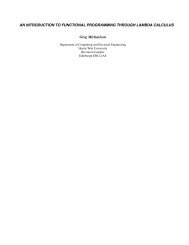Contents
Contents
Contents
You also want an ePaper? Increase the reach of your titles
YUMPU automatically turns print PDFs into web optimized ePapers that Google loves.
AMATH 581 ( c○J. N. Kutz) 33slope=rise/run=(0-f( ) )/( - )x n x n+1 x nx 1xnx 3 x 0 x 4 x 2x n+1f( x n+1 )f( x n )(a)(b)Figure 11: Construction and implementation of the Newton-Raphson iterationformula. In (a), the slope is the determining factor in deriving the Newton-Raphson formula. In (b), a graphical representation of the iteration scheme isgiven.the scheme either converges to the root x r or the scheme diverges and anotherinitial guess is used. The sequence of guesses (x 0 ,x 1 ,x 2 ,...)isgeneratedfromthe slope of the function f(x). The graphical procedure is illustrated in Fig. 11.In essence, everything relies on the slope formula as illustrated in Fig. 11(a):slope = df (x n)dx= riserun = 0 − f(x n)x n+1 − x n. (1.5.16)Rearranging this gives the Newton-Raphson iterative relationx n+1 = x n − f(x n)f ′ (x n ) . (1.5.17)Agraphicalexampleofhowtheiterationprocedureworksisgiven in Fig. 11(b)where a sequence of iterations is demonstrated. Note that the schemefailsiff ′ (x n )=0sincethentheslopelineneverintersectsy =0. Further,forcertainguesses the iterations may diverge. Provided the initial guess is sufficiently close,the scheme usually will converge. Conditions for convergence can be found inBurden and Faires [5].The Newton method can be generalized for system of nonlinear equations.The details will not be discussed here, but the Newton iteration scheme is similarto that developed for the single function case. Given a system:⎡F(x n )= ⎢⎣f 1 (x 1 ,x 2 ,x 3 ,...,x N )f 2 (x 1 ,x 2 ,x 3 ,...,x N ).f N (x 1 ,x 2 ,x 3 ,...,x N )⎤⎥⎦ = 0 , (1.5.18)
















